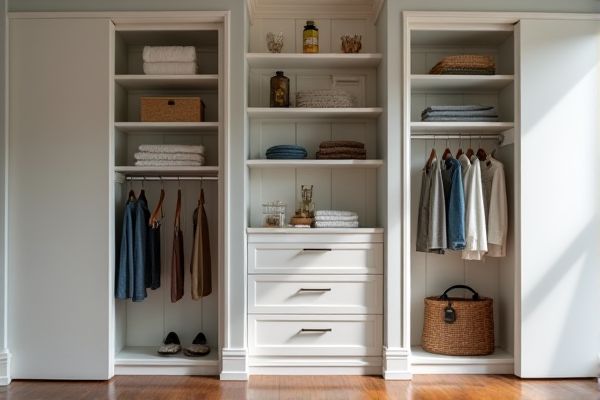
Molded closets offer solid, durable storage with a clean, finished look, while wire closets provide ventilation and flexibility for easy customization. Discover which closet type best suits your storage needs and enhances your space by reading the full article.
Table of Comparison
| Feature | Molded Closet | Wire Closet |
|---|---|---|
| Material | High-density molded wood or composite | Coated steel wire |
| Durability | Strong, resistant to warping and damage | Durable but prone to bending under heavy load |
| Design | Solid panels, customizable finishes | Open grid design, airy and visible |
| Installation | Moderate, requires precise fitting | Easy, typically adjustable and modular |
| Ventilation | Poor, less airflow | Excellent, prevents moisture buildup |
| Weight Capacity | High, supports heavy items | Moderate, best for light to medium loads |
| Maintenance | Easy to clean, prone to scratches | Low maintenance, rust can occur if coating damaged |
| Cost | Higher initial investment | More affordable |
| Best Use | Professional closets, solid storage | Garage, pantry, or light storage |
Understanding Molded Closets
Molded closets are crafted from durable plastic or composite materials, providing a smooth, solid surface that is easy to clean and resistant to moisture. These closets offer a sleek, uniform appearance with built-in shelving and compartments that maximize storage efficiency. Molded closets are ideal for environments requiring sturdy, low-maintenance solutions, outperforming wire closets in durability and aesthetics.
What Are Wire Closets?
Wire closets consist of metal wire shelves and rods, providing ventilated storage that prevents dust buildup and allows air circulation, ideal for organizing clothes and accessories. These closets are lightweight, adjustable, and easy to install, often used in closets or laundry rooms for their durability and low maintenance. Wire closet systems offer cost-effective, customizable solutions compared to molded closets, enhancing functionality in various home storage spaces.
Design and Aesthetics Comparison
Molded closets feature a sleek, uniform appearance with smooth surfaces and a polished finish that enhances modern and traditional bedroom designs. Wire closets, constructed from metal grids, provide a more industrial or utilitarian look while allowing better ventilation and visibility of stored items. Your choice depends on whether you prioritize a clean, seamless design or a practical, airy aesthetic.
Installation Process: Molded vs Wire Closets
Molded closets feature pre-fabricated panels that streamline the installation process, requiring minimal tools and less time for assembly. Wire closets utilize modular components that allow for flexible customization but often demand more precise measuring and anchoring for secure installation. The choice between molded and wire closets depends on balancing ease of installation with desired design adaptability.
Durability and Longevity
Molded closets offer superior durability and longevity due to their solid construction from high-quality plastic or composite materials, resisting warping and damage over time. Wire closets, while lightweight and breathable, tend to be less durable as they can bend, rust, or break under heavy loads or prolonged use. Choosing a molded closet ensures your storage solution maintains structural integrity and appearance for years, providing better long-term value for your organization needs.
Storage Efficiency and Customization
Molded closets offer superior storage efficiency with built-in shelves and compartments designed to maximize space utilization, allowing you to organize items neatly and access them easily. Wire closets provide flexibility and customization options through adjustable racks and hanging systems, but may lack the solid structure needed for heavier items or smaller accessories. Choosing between molded and wire closets depends on your storage needs, balancing the desire for tailored organization with the ability to modify configurations frequently.
Maintenance and Cleaning Needs
Molded closets require minimal maintenance as their smooth surfaces resist dust and stains, making cleaning quick with just a damp cloth. Wire closets often accumulate dust and debris in the gaps, demanding more frequent and thorough cleaning using brushes or vacuum attachments. The non-porous nature of molded closets prevents mold and mildew growth better than the open design of wire closets, which can trap moisture.
Cost Analysis: Molded vs Wire Closets
Molded closets typically cost more upfront due to durable materials like engineered wood or composite, averaging $500 to $1,200 depending on size and customization. Wire closets are more budget-friendly, with prices ranging from $100 to $400, making them ideal for cost-conscious homeowners seeking functionality. While molded closets offer enhanced aesthetics and sturdiness, wire closets provide easy installation and flexibility at a lower price point.
Best Use Cases for Each Closet Type
Molded closets are ideal for high-moisture areas such as bathrooms and laundry rooms due to their water-resistant, durable surfaces that prevent mold and mildew growth. Wire closets excel in ventilated spaces like walk-in closets and pantries, allowing air circulation that helps keep clothes fresh and prevents odors. For heavy-duty storage needs, molded closets provide superior strength and stability, while wire closets offer flexibility and customization options for organizing various items.
Choosing the Right Closet for Your Home
Molded closets offer a sleek, durable design made from solid materials, providing enhanced stability and a polished look that complements modern interiors. Wire closets excel in ventilation and customization, allowing you to easily adjust shelving and maximize airflow to prevent moisture buildup. Assess your storage needs, budget, and desired aesthetic to determine whether a molded or wire closet best suits your home's organization and style preferences.
 homyna.com
homyna.com